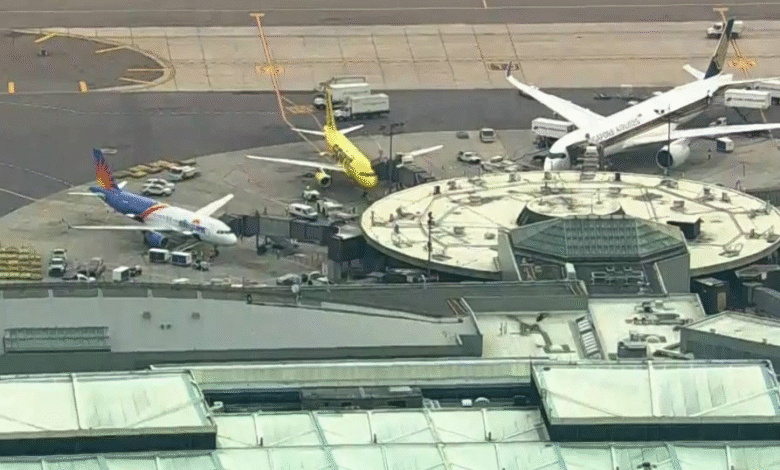Newark Airport Flight Disruptions: FAA Meeting to Address Issues

Newark airport flight disruptions have become a pressing concern as U.S. airlines prepare to meet with the FAA to tackle the increasing number of flight delays Newark is experiencing. A recent spate of equipment failures and critical air traffic control issues has resulted in significant operational challenges, leading to over 1,000 delays just last month alone. Transportation Secretary Sean Duffy has warned that what is happening in Newark may soon affect airports nationwide unless addressed promptly. Further complicating the situation are airline flight cuts, with major carriers like United Airlines reducing their schedules by 10% to help manage the chaos. Coupled with ongoing Newark airport construction delays, travelers are bracing for continued turbulence in their flying plans this summer.
Recent travel turmoil at Newark Liberty International Airport, marked by significant flight disruptions, has raised alarms about broader systemic issues affecting air travel. With ongoing challenges such as FAA flight schedule changes, inadequate air traffic management, and infrastructure shortcomings, many passengers are finding themselves at the mercy of delayed departures and canceled flights. The situation has prompted urgent discussions among airline executives and federal officials about necessary measures to alleviate the strain on air traffic systems. Particularly, the ongoing runway renovations have compounded delays, leaving travelers to navigate an increasingly unpredictable flying environment. As Newark faces these operational hurdles, the aviation industry is compelled to confront and rectify the underlying problems to ensure smoother travel experiences in the future.
Understanding Newark Airport Flight Disruptions
Flight disruptions at Newark Liberty International Airport have become a significant concern for travelers and airlines alike. Recent incidents, including equipment failures and air traffic controller shortages, have led to hundreds of delays, prompting a critical review of the airport’s operational capacity. With the summer travel season in full swing, many travelers have experienced the impact firsthand, waiting hours for updates and cancellations. It’s essential to grasp the underlying causes of these disruptions, as they not only affect Newark but are indicative of broader systemic issues within the U.S. air traffic control infrastructure.
The FAA has acknowledged the ongoing issues caused by a combination of technical failures and a diminishing workforce of air traffic controllers. As noted by Transportation Secretary Sean Duffy, these disruptions at Newark are likely to replicate across other major airports if left unaddressed. The importance of timely communication and effective management becomes paramount as airlines, such as United Airlines, voluntarily reduce their flight schedules to facilitate operational integrity. This proactive measure highlights the impact of Newark airport flight disruptions on overall airline scheduling and passenger experience.
The Impact of FAA Flight Schedule Changes
The FAA’s recent discussions regarding flight schedule changes at Newark are crucial in addressing the growing challenges faced by the airport. With incidents leading to severe disruptions, the need for effective schedule management has never been more evident. Flight schedules that once allowed for optimal capacity now frequently push beyond safe operating limits, resulting in delays and cancelations. The FAA’s efforts to implement strategic reductions underscore the urgency of these changes, as they aim to harmonize aircraft movements with the available air traffic control resources.
These FAA flight schedule changes will not only affect Newark residents but also travelers from various regions seeking to connect through one of the busiest airports in the country. Airlines are scrambling to adapt their operations, which may include cutting certain flights or adjusting service routes to align with new FAA recommendations. By minimizing congestion and aligning schedules with available resources, the FAA aims to mitigate flight delays Newark has been experiencing, enhancing the overall travel experience.
Addressing Air Traffic Control Issues at Newark Airport Train Station: Solutions Ahead!
Addressing Air Traffic Control Issues at Newark Airport
Air traffic control issues have emerged as a primary contributor to the disruptions at Newark Airport. The recent incidents, such as the temporary communication blackout, emphasize the vulnerabilities in the current system. With 1,000 flight delays reported following air traffic controller shortages, the implications of these issues are far-reaching, affecting not just travelers but the airline industry at large. The situation highlights the urgent need for upgrades to the aging infrastructure and enhancements in staffing levels to ensure efficient air traffic management.
The FAA’s acknowledgment of these air traffic control challenges is a critical first step. The recent failures underline the necessity for comprehensive reforms to prioritize technological modernization and workforce expansion. Airlines must work closely with the FAA to develop strategies that safeguard the operational readiness of busy airports like Newark. As the FAA aims for a more robust and resilient air traffic control framework, collaboration among all stakeholders is vital for crafting a sustainable solution to these pressing challenges.
Airline Flight Cuts and Operational Pressure
In response to the growing operational pressure caused by Newark’s flight disruptions, airlines have increasingly resorted to reducing their flight schedules. Particularly, United Airlines, the primary carrier operating at Newark, has announced voluntary cuts to their daily flights to alleviate congestion on the runways. This operational reshaping is indicative of a larger trend within the aviation industry as airlines strive to maintain operational efficiency amid ongoing challenges. By adjusting their schedules, airlines aim to ensure that they can meet traveler demand while also navigating air traffic constraints and equipment failures.
These airline flight cuts come at a significant cost to both passengers and airlines, as reduced service means fewer options and potentially longer wait times for travelers. However, airline executives argue that this approach is essential for stabilizing operations and reducing delays. The dynamic nature of air traffic and the pressures from FAA regulations mean that quick adjustments are often necessary to facilitate smoother operations at Newark and prevent a domino effect of delays throughout the national air traffic system.
The Role of Newark Airport Construction Delays
Construction delays at Newark Airport have been another contributing factor to the recent wave of flight disruptions. Ongoing runway maintenance and enhancements, while aimed at improving infrastructure in the long run, have compounded current air traffic issues, resulting in bottlenecks and longer wait times for arrivals and departures. As travel demands peak during the summer season, the disruptions caused by these construction projects create substantial challenges for airlines trying to manage their schedules effectively.
While the intention behind Newark airport construction is to modernize facilities and enhance passenger experiences, the interim phase presents significant operational hurdles. As airlines navigate reduced runway availability and increased congestion, the immediate effects ripple through the entire travel system. Effective communication between airport management, the FAA, and the airlines is crucial to ensure that all parties are aware of construction timelines and their potential impact on flight schedules. Only with careful planning and coordination can the negative impacts of construction delays be mitigated.
The Consequences of Aging Air Traffic Control Infrastructure
The aging U.S. air traffic control infrastructure is in the spotlight more than ever, particularly in light of the disruptions at Newark Airport. Reports of equipment failures highlight the urgent need for modern advancements and renovations in technology used to manage air traffic. If these antiquated systems continue to be relied upon, instances of flight delays and cancellations will only escalate, jeopardizing travel reliability across the nation.
In addition to the immediate implications for Newark, the distress signals from these incidents signify broader issues that could impact other airports nationwide. Transportation Secretary Sean Duffy has stressed that without significant investment and modernization, the safety and efficiency of the air travel system could face widespread consequences. The call for $31 billion in funding for upgrades is a strong message about the need to prioritize aviation infrastructure as essential to the overall functionality of air transportation.
Preparing for Future Flight Disruptions
As Newark continues to grapple with current flight disruptions, the focus must shift towards preparedness for future incidents. Airlines and the FAA must develop robust contingency plans that address not only equipment failures but also staffing shortages. This requires an investment in training and hiring new air traffic controllers who can handle the increasingly busy airspace, especially during peak travel seasons. Ensuring that there are sufficient resources in place will serve as a preventive measure against further disruptions.
Moreover, clear communication with passengers must be maintained during times of disruption. Providing timely updates on flight status and options can significantly alleviate traveler frustration. By enhancing customer support during delays, airlines can foster a more positive travel experience despite operational challenges. Ultimately, preparing for future disruptions means taking proactive steps to enhance efficiency and reliability, ensuring that Newark Airport can handle the demands of air travel in the years to come.
Collaboration Among Airlines, FAA, and Government
The complexity of issues facing Newark Airport not only reflects the operational challenges but also points to the necessity of collaboration between airlines, the FAA, and government agencies. By coming together, stakeholders can create actionable strategies to overcome ongoing disruptions and implement improvements in air traffic management. Regular meetings and discussions are vital in fostering a unified approach to managing flight schedules, addressing air traffic control issues effectively, and ensuring the safety and efficiency of the air travel system.
Moreover, an aligned approach can lead to a shared understanding of the demands placed on the aviation system, allowing for more effective resource allocation. As evidenced by the discussions surrounding flight cuts and construction delays, transparency and communication are essential for building trust and ensuring all parties are well-informed about operational capacities. This collaboration will serve not just Newark Airport but could set valuable precedents for airports nationwide facing similar congestion challenges.
The Economic Implications of Flight Disruptions
Flight disruptions at Newark Airport have considerable economic implications beyond the immediate inconvenience faced by passengers. Delayed or canceled flights can have a cascading effect, not just on airlines but also on businesses that rely on timely air travel. Economic activity in the surrounding region can suffer as companies face challenges in logistics, attracting clients, and maintaining scheduled operations. Therefore, addressing these disruptions is not merely a logistical issue; it also has far-reaching consequences for local and national economies.
Understanding the economic ramifications of airport disruptions provides a compelling incentive for stakeholders to invest in necessary infrastructure and staffing improvements. As travelers seek alternatives during flight disruptions, they may choose other airports or modes of transport, resulting in lost revenue for both Newark and the airlines. Additionally, ongoing discussions regarding budget allocations for air traffic control upgrades are tied directly to the understanding that maintaining a stable travel environment is crucial for sustaining economic growth across the aviation sector.
Public Awareness and Passenger Rights During Disruptions
As flight disruptions at Newark become more frequent, raising public awareness about passenger rights during these situations is paramount. Passengers should be informed of their rights concerning compensation and accommodations when flights are delayed or canceled. Understanding these rights empowers travelers, enabling them to assert their needs in stressful situations and seek appropriate remedies. Airlines, in conjunction with regulatory bodies, should ensure that passengers are not only informed of these rights but also that the processes for claims are streamlined and accessible.
In addition to passenger rights, enhancing public awareness surrounding ongoing improvements in air traffic management and infrastructure can instill confidence in travelers. By promoting transparency in how the FAA and airlines are collaborating to address issues, customers may feel more reassured about their travel plans. Furthermore, public forums or information sessions could be established to educate travelers on what efforts are being undertaken to prevent future disruptions at Newark and how they can expect their travel experience to improve moving forward.
Frequently Asked Questions
What are the main causes of Newark airport flight disruptions?
Newark airport flight disruptions are primarily caused by a combination of equipment failures, air traffic controller shortages, and ongoing runway construction delays. Recent incidents have highlighted vulnerabilities in the aging U.S. air traffic control infrastructure, leading to significant flight delays and disruptions.
How do flight delays at Newark impact travelers?
Flight delays at Newark can significantly affect travelers’ plans, causing missed connections, longer waiting times, and increased travel stress. With multiple airlines, including United Airlines, announcing flight cuts due to operational pressures, passengers should stay informed about their flight status and potential delays.
What actions is the FAA taking to address Newark airport flight disruptions?
The FAA is meeting with U.S. airlines to discuss reducing flights at Newark due to recent disruptions caused by equipment issues and air traffic control challenges. The meeting aims to implement changes that could alleviate congestion and improve the overall flight schedule at Newark airport.
Are there any specific airline flight cuts at Newark due to disruptions?
Yes, United Airlines has announced a voluntary reduction of 35 flights, which represents about 10% of its daily schedule at Newark. This decision is aimed at easing operational pressures and improving timely flight departures amid ongoing disruptions.
What is being done to improve air traffic control issues at Newark airport?
Efforts to address air traffic control issues at Newark airport include a plan presented by industry officials to modernize the air traffic control infrastructure. However, significant investments, estimated at $31 billion, are needed to upgrade equipment and hire additional controllers to prevent future flight disruptions.
How are construction delays affecting Newark airport’s flight schedule?
Ongoing runway construction at Newark is exacerbating flight disruptions and delays, particularly during peak travel seasons. Travelers should expect increased wait times and should plan accordingly when flying through Newark airport.
What should passengers do to stay informed about Newark airport flight disruptions?
Passengers should regularly check their airline’s website or app for real-time flight updates regarding Newark airport flight disruptions. Additionally, the FAA and airport’s official social media channels can provide timely information related to any operational changes.
Will Newark airport flight disruptions affect flights to and from major cities?
Yes, Newark airport flight disruptions can have a ripple effect on flights to and from major cities, as many airlines reroute or reschedule flights based on the current conditions at Newark. Travelers should be proactive in checking their flight status, especially when connecting through Newark.
How can I prepare for potential Newark airport flight delays?
To prepare for potential Newark airport flight delays, travelers should arrive at the airport early, stay updated on flight statuses via airline notifications, and consider flexible travel plans that account for potential disruptions.
| Key Point | Details |
|---|---|
| Meeting with FAA | U.S. airlines to reduce flights at Newark due to disruptions. |
| Cause of Disruptions | Equipment failures and air traffic controller shortages leading to over 1,000 flight delays. |
| Secretary’s Statement | Sean Duffy warns that issues seen in Newark could occur nationwide. |
| Air Traffic Control Issues | Controllers lost communication for 90 seconds last month; stress-induced leaves taken. |
| Runway Construction Impact | Ongoing construction is exacerbating delays as summer travel season nears. |
| Infrastructure Investment Needed | Industry estimates $31 billion required for upgrades and hiring of controllers. |
| Flight Schedule Reductions | United Airlines cuts 35 flights to ease operational pressure, handling capacity concerns. |
| Future Meetings | FAA and airlines to discuss schedule reductions further on Wednesday at 9 a.m. |
| Need for Modernization | Recent developments underscore necessity to invest in aviation infrastructure to reduce disruptions. |
Summary
Newark airport flight disruptions have become a significant concern following a series of equipment failures and staff shortages within the air traffic control system. As U.S. airlines prepare to meet with the FAA to address these issues, the urgency for modernizing infrastructure and improving operational capacity has never been clearer. Without immediate action, the ongoing challenges at Newark could set a precedent for similar disruptions at airports across the country, affecting countless travelers and the national aviation system.




